The Treaty of Edinburgh–Northampton was a peace treaty signed in 1328 between the Kingdoms of England and Scotland.

An indenture is a legal contract that reflects or covers a debt or purchase obligation. It specifically refers to two types of practices: in historical usage, an indentured servant status, and in modern usage, it is an instrument used for commercial debt or real estate transaction.

The Textus Roffensis, fully titled the Textus de Ecclesia Roffensi per Ernulphum episcopum and sometimes also known as the Annals of Rochester, is a mediaeval manuscript that consists of two separate works written between 1122 and 1124. It is catalogued as "Rochester Cathedral Library, MS A.3.5" and as of 2023 is currently on display in a new exhibition at Rochester Cathedral, Rochester, Kent. It is thought that the main text of both manuscripts was written by a single scribe, although the English glosses to the two Latin entries were made by a second hand. The annotations might indicate that the manuscript was consulted in some post-Conquest trials. However, the glosses are very sparse and just clarify a few uncertain terms. For example, the entry on f. 67r merely explains that the triplex iudiciu(m) is called in English, ofraceth ordel.

The Vercelli Book is one of the oldest of the four Old English Poetic Codices. It is an anthology of Old English prose and verse that dates back to the late 10th century. The manuscript is housed in the Capitulary Library of Vercelli, in northern Italy.

Æthelred was an Anglo-Saxon Archbishop of Canterbury in medieval England. Although one source states that he was Bishop of Wiltshire prior to his elevation to Canterbury, this has been shown to be false. Much of Æthelred's time in office was spent dealing with the dislocations caused by the invasion of England by Vikings. There were also conflicts with King Alfred the Great over ecclesiastical matters as well as the desire of the papacy to reform the English clergy.

The Chinon Parchment is a historical document discovered in September 2001 by Barbara Frale, an Italian paleographer at the Vatican Apostolic Archive. On the basis of this document she has claimed that, in 1308, Pope Clement V absolved the last Grand Master, Jacques de Molay, and the rest of the leadership of the Knights Templar from charges brought against them by the Medieval Inquisition.

Anglo-Saxon charters are documents from the early medieval period in England which typically made a grant of land or recorded a privilege. The earliest surviving charters were drawn up in the 670s: the oldest surviving charters granted land to the Church, but from the eighth century, surviving charters were increasingly used to grant land to lay people.

A foot of fine is the archival copy of the agreement between two parties in an English lawsuit over land, most commonly the fictitious suit known as a fine of lands or final concord. The procedure was followed from c.1195 until 1833, and the considerable body of resulting records is now held at The National Archives, Kew, London.

Sarah Rosamund Irvine Foot, is an English Anglican priest and early medieval historian. She has been Regius Professor of Ecclesiastical History at the University of Oxford since 2007, and Dean of Christ Church, Oxford since 2023.
Abraham Wheelock was an English linguist. He was the first Cambridge professor of Arabic.
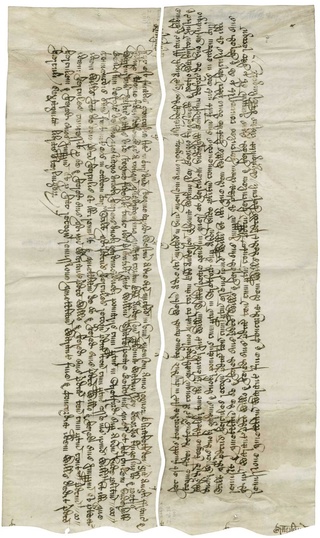
A fine of lands, also called a final concord, or simply a fine, was a species of property conveyance which existed in England from at least the 12th century until its abolition in 1833 by the Fines and Recoveries Act.
The Historia Regum is a historical compilation attributed to Symeon of Durham, which presents material going from the death of Bede until 1129. It survives only in one manuscript compiled in Yorkshire in the mid-to-late 12th century, though the material is earlier. It is an often-used source for medieval English and Northumbrian history. The first five sections are now attributed to Byrhtferth of Ramsey.
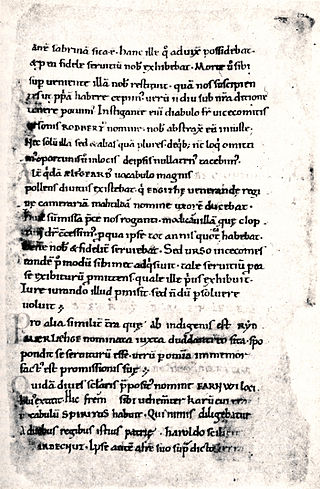
Hemming's Cartulary is a manuscript cartulary, or collection of charters and other land records, collected by a monk named Hemming around the time of the Norman Conquest of England. The manuscript comprises two separate cartularies that were made at different times and later bound together; it is in the British Library as MS Cotton Tiberius A xiii. The first was composed at the end of the 10th or beginning of the 11th century. The second section was compiled by Hemming and was written around the end of the 11th or the beginning of the 12th century. The first section, traditionally titled the Liber Wigorniensis, is a collection of Anglo-Saxon charters and other land records, most of which are organized geographically. The second section, Hemming's Cartulary proper, combines charters and other land records with a narrative of deprivation of property owned by the church of Worcester.

The Anglo-Saxon Chronicle is a collection of annals in Old English, chronicling the history of the Anglo-Saxons.
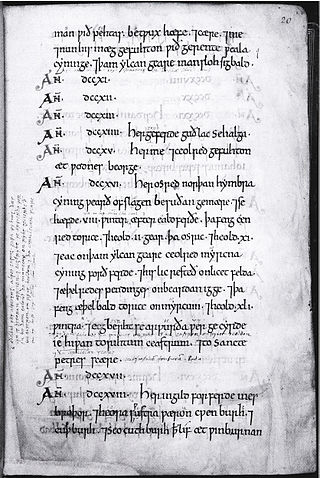
John Joscelyn, also John Jocelyn or John Joscelin, (1529–1603) was an English clergyman and antiquarian as well as secretary to Matthew Parker, an Archbishop of Canterbury during the reign of Queen Elizabeth I of England. Joscelyn was involved in Parker's attempts to secure and publish medieval manuscripts on church history, and was one of the first scholars of the Old English (Anglo-Saxon) language. He also studied the early law codes of England. His Old English dictionary, although not published during his lifetime, contributed greatly to the study of that language. Many of his manuscripts and papers eventually became part of the collections of Cambridge University, Oxford University, or the British Library.

Frithegod, was a poet and clergyman in the mid 10th-century who served Oda of Canterbury, an Archbishop of Canterbury. As a non-native of England, he came to Canterbury and entered Oda's service as a teacher and scholar. After Oda's death he likely returned to the continent. His most influential writing was a poem on the life of Wilfrid, an 8th-century bishop and saint, named Breviloquium Vitae Wilfridi. Several manuscripts of this poem survive, as well as a few other of Frithegod's poems. He was also known for the complexity of his writings, with one historian even calling them "damnably difficult".
The Gesta Pontificum Anglorum, originally known as De Gestis Pontificum Anglorum and sometimes anglicized as The History or The Chronicle of the English Bishops, is an ecclesiastical history of England written by William of Malmesbury in the early 12th century. It covers the period from the arrival of St Augustine in AD 597 until the time it was written. Work on it was begun before Matilda's death in 1118 and the first version of the work was completed in about 1125. William drew upon extensive research, first-hand experience and a number of sources to produce the work. It is unusual for a medieval work of history, even compared to William's other works, in that its contents are so logically structured. The History of the English Bishops is one of the most important sources regarding the ecclesiastical history of England for the period after the death of Bede.
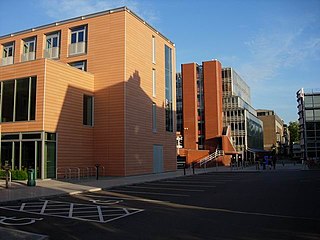
The Department of Anglo-Saxon, Norse and Celtic is one of the constituent departments of the University of Cambridge, and focuses on the history, material culture, languages and literatures of the various peoples who inhabited Britain, Ireland and the extended Scandinavian world in the early Middle Ages. It is based on the second floor of the Faculty of English at 9 West Road. In Cambridge University jargon, its students are called ASNaCs.
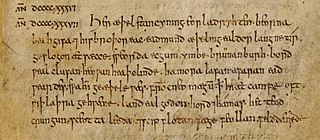
The "Battle of Brunanburh" is an Old English poem. It is preserved in the Anglo-Saxon Chronicle, a historical record of events in Anglo-Saxon England which was kept from the late ninth to the mid-twelfth century. The poem records the Battle of Brunanburh, a battle fought in 937 between an English army and a combined army of Scots, Vikings, and Britons. The battle resulted in an English victory, celebrated by the poem in style and language like that of traditional Old English battle poetry. The poem is notable because of those traditional elements and has been praised for its authentic tone, but it is also remarkable for its fiercely nationalistic tone, which documents the development of a unified England ruled by the House of Wessex.

The Cleopatra Glossaries are three Latin-Old English glossaries all found in the manuscript Cotton Cleopatra A.iii. The glossaries constitute important evidence for Old English vocabulary, as well as for learning and scholarship in early medieval England generally. The manuscript was probably written at St Augustine's, Canterbury, and has generally been dated to the mid-tenth century, though recent work suggests the 930s specifically.
















